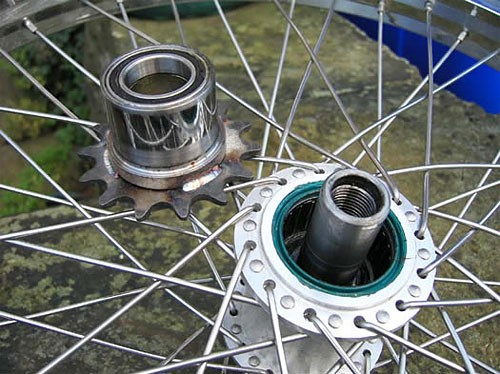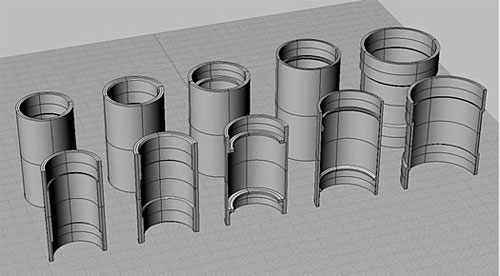Click, click, click..
*This article first appeared in Ride UK (#82) and is reproduced here by kind permission of Ride UK.
Click click click. Or if you are running certain cassette hubs; CLICK CLICK BASTARD CLICK CLICK CLICK, or even CKCKCKCKCKCKCKCKCK.
Some people seem to like a really loud click when they freewheel, some people hate it.
Personally I hate it, it’s the ultimate give-away to security guards and police. If you need to sneak about to get to a street spot then having some fucker’s cassette hub making super loud clicks that can be heard two streets away is kind of a bummer. On the other hand I really can understand how some riders find it a useful indication of their speed. “Click… click… click…”; too slow. “CKCKCKCKCK” too fast. “Clk, clk, clk,”; just right… But is there anything you can do about it either way?
Yes.
The click you hear is each pawl of the cassette or freewheel as it springs out after each tooth has passed and it smacks into the trough between teeth. If you fill the mechanism with thick grease then it will “damp” this movement and cushion the impact of the pawl against the toothed part of the hub. So adding thick grease will quieten the hub substantially. Unfortunately if you over-do this then the pawl might not make it all the way back to position between each tooth and it might slip under load. Far from ideal.
If on the other hand, you clean out what grease there is in there, and replace it with just a very thin smear of thin oil, then there will be almost no resistance for the pawl and it will make the loudest click possible (and be less likely to skip or slip).
Between these two extremes there are an infinite number of options, different thicknesses of grease and oil will give varying degrees of damping and therefore sound level.
With cassettes and freewheels that use individual springs under each pawl, you can also bend these springs out a little to give more spring and so more noise (or less chance of slipping with a thicker quieter grease).
At this point it is useful to know that you can “thin” grease by mixing in more oil (grease is traditionally just an emulsion of oil and water with ‘soap’). Take your normal grease and mix in some WD40 or other thin oil and it will become thinner and less viscous.
While we are on the general subject, it is worth mentioning that all freewheels and cassette hubs need a little love now and again. If your freewheel or cassette hub is slipping or making nasty noises then it will need a bit of attention.
With freewheels, taking them apart IS an option but its not much fun so make it the last resort. Instead, just dripping some thin oil in through the crack between the toothed part and the “body” is often all it needs. And by “dripping some” I do of course mean “pissing a shed load”. With freewheels this oil needs to do the job of both cleaning and lubing so you need enough to wash any “crap” out the back. Keep spinning the freewheel to work it through and you should notice a dramatic improvement.
With cassette hubs you MUST take them apart to clean and re-lube them. Getting thin oil like WD40 into the wheel or driver bearings is a death sentence (this applies to freewheel hubs too so keep it away from the hub bearings).
Most cassettes are fairly easy to take apart but those pawls and springs can and will make a bid for freedom so keep an eye on them and be ready to catch them.
With all cassette hubs you will need to undo the cones from at least one side and completely remove them to get the driver off. Once you have done this simply pull the driver gently out of the hub. With some hubs the axle will remain in the hub and with others it will come out with the driver (this type, like the newer Odyssey cassettes, will need the non-drive side’s cone nuts removing to allow the axle to come out). If in doubt just remove BOTH sides.
Once you have the driver out, wipe out the insides with an old rag and then apply your chosen lubricant. A light smear of thin oil (like brake-cable lube) for those who like the noise; a small amount of thin grease for the stealthier rider; and a carefully judged thicker grease for those who need to be as quiet as possible.
While you have the hub apart take the opportunity to inspect everything especially the axle. Spin the axle slowly in the hub and look for “wobble”. Or roll it along a flat surface. If it wobbles or looks bent then replace it straight away.
Remember that the bearings are locked to the axle by the cone nuts, so if the axle is out of line at the bearing seats, then the bearings are no longer lined up with each other. So as the wheel rotates the bearings try to angle inside the hubshell on every turn to line up with the axle. This soon leads to them wearing out the bearing seats in the hub shell and that is that for the hub. Repair is next to impossible and your only realistic option is a new hub.
On the same subject; have you ever noticed how cassettes and freewheels are often advertised as having many more pawls or teeth for; “faster engagement” ? Who asked for this? Why is it a GOOD thing?
The truth is that faster engagement can be a real pain in the arse… literally.
A few years ago, as an experiment, I made a prototype hub that used a ‘one way roller bearing’. One way roller bearings are a type of very expensive needle roller bearing where each roller sits on a little ramp held against it and the outer shell by a tiny spring. In one direction it sort of rolls and in the other it jams up INSTANTLY. The hub has literally “zero slack”. It felt amazing.
Going forward it made no clicks, was absolutely silent and smooth as hell.
Going backward, even a little bit, it just threw you off the bike.
It may seem hard to believe, but with an ordinary freewheel or cassette hub you get a fraction of a second to absorb any backward landing, before it asks you to back-pedal.
With the roller hub the very moment that the back tyre touches down it forces the front pedal up at you super hard. But at the moment of landing you also have to be coping with the forces of your landing.
In other words, with a normal set-up you land, on both pedals and then start pedaling back. With the roller hub you land on two pedals where the front pedal is coming up at you twice as hard as the back pedal which is trying to retreat from under your foot. The result of all this is that it blows you straight off the bike and onto your arse…
The experience of the roller-bearing hub taught me that some slack in the drive-train is essential, so why are companies bragging about having reduced it nearly to zero?!?!
Obviously too much slack can be a pain too but there is definitely a “right amount”. Don’t be impressed by claims of near instant or instant engagement; at the starting gate it may be a help, but on street it’s totally counter-productive.

Bottom Bracket News Continued…… again
Well you cant honestly say you are surprised can you? That’s right its time for another instalment of bottom bracket news….
But this month it is at least partially good news.
Since the last article on the continuing bottom bracket saga, FBM have gone ahead and launched their “Mid Size” bottom bracket. If you can remember from 3 issues ago, the FBM Mid Size uses the standard bearings that come stock with Profile and other ¾” (19mm) axled-cranks. They press straight into the frame and offer bearings with a proven track record for strength, but in an easy to fit styley. The downside is that other sizes of crank like (22mm) Powerbites, just wont work with it.
Well now that may be about to change. Haro/Premium have taken quite a liking to the Mid Size (after apparently having some problems with breaking Spanish Bottom Bracket bearings) and are talking seriously about making a custom bearing to allow the Mid Size to accept 22mm axled cranks… This still leaves little room for future development on new crank axle sizes though…
Also a new(ish) development since the last article on this subject:-
The Sputnik frame uses normal euro bottom bracket bearings but in a press fit shell rather than the traditional threaded euro. On the rumour mill Profile are said to be working on their own bottom bracket standard, and S+M still haven’t declared what they are going to do.

From left to right: Unthreaded Sputnic ‘Euro’, Traditional Euro, Spanish BB, Mid Size, USA


